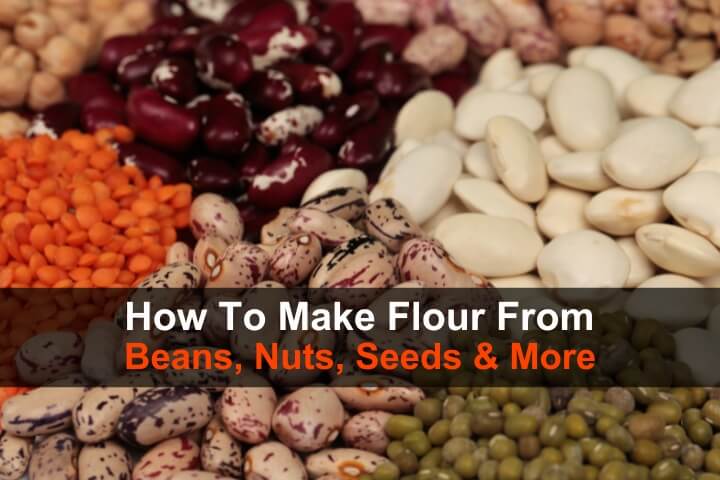There Are Still Some Shortages of Flour At The Grocery Store, But Your Pantry May Have Some Flours You Simply Haven’t Seen.
An old pioneer method for making flour was to use a hand-cranked flour mill to grind wheat grains into flour. That works. But a flour mill can turn lots of things into flour, from beans or rice to acorns and amaranth seeds.
And you don’t need a flour mill to do it. A food processor can convert a lot of things into dust, from corn flakes to chickpeas. That’s essentially what defines any flour—something pulverized to dust.
Want to save this article for later? Click Here to Pin it On Pinterest!
Stretch Your Budget
You can add your new flour varieties to any white flour to stretch your current flour supply. If you have some bread flour on hand, that’s all the better, and you can stretch your (high-gluten) bread flour over more recipes by combining it with other homemade flours. We’ll cover some gluten-free flours as well, along with the recipes that go with them.
And it’s not just about baking. Meat prices have gone up. A local grocery store recently had a pound of hamburger marked at $7.99 a pound. That’s high. But you can stretch the ground beef by adding black bean flour to the hamburger. It not only helps to bind the patties (especially for grilling), it also adds protein—and it tastes good too.
Let’s Get Started
We’re going to start with a flour mill. You can buy them on Amazon. They come in both electric and manual, hand-cranked models. The hand-cranked version is more in keeping with the pioneer spirit, so we’re going to go that route, although electric mills are easier to use.
Flour Mills 101
There are essentially two grinding options with a flour mill. One is to use two metal serrated plates for a coarse grind for cracked corn or cracked wheat, or as a preliminary step for coarser grains and beans.
The other option is to use two stone wheels to convert something into a fine flour. In many cases, you’ll use both in a two-step process.
The first step is to crack or create a coarse grind. This is especially helpful with corn, beans, and peas.
The second step is to take the coarse grind and grind it further with the stone wheels to finish the flour. The stone wheels can be tightened or loosened to adjust the fineness of the grind.
When choosing a flour mill, consider the types of grains, beans, or nuts you’ll be processing. Some mills are better suited for oily nuts, while others excel at grinding hard grains. It’s essential to choose a mill that is best for your specific needs.
The Food Processor Option
A food processor can make quick work of flour making, but there’s a unique challenge you’ll face if you’re using a food processor to make flour. Any source material, whether its corn or beans, needs to be as dry as possible.
If there’s any moisture in the form of water or natural oils, you’ll end up with something resembling peanut butter rather than flour. That’s okay if that’s what you want, and any nuts will easily give you a nut butter in a food processor, but the objective here is to make flour, so make sure your seed or bean source is very dry.
You could also use your food processor as a preliminary step for grinding in your flour making. The food processor can quickly give you a coarse grind that will allow you to go directly to the stone grinding wheels to make flour. Experiment as you go, and if the processor doesn’t give you a good result, try the metal grinding wheels on your flour mill.
For those without a flour mill or food processor, there are a few other methods. A high-powered blender can handle small batches of grains or seeds, though it may require multiple passes to get a fine consistency.
Additionally, manual methods such as a mortar and pestle can be used for small quantities, but it will wear out your hands after a while.
Flour Options and Recipes
We’re not going to get too specific about how many grains, seeds, or beans you use to make your flour. Make as much as you need for a recipe or as much as you want to store.
1. Rice Flour
Rice flour has become popular as a gluten-free flour alternative. It’s easy to make from white or brown rice.
Rice Flour Directions:
- Add the rice to the flour mill hopper.
- Use the stone grinding wheels.
- Grind until hopper is empty and your rice flour is done.
Rice Flour Loaf Recipe
Ingredients:
- 3 eggs room temperature (or egg substitute equivalent)
- 1 ½ cups warm water
- 3 tablespoons of vegetable oil
- 1 teaspoon apple cider vinegar
- 2 ¼ teaspoons of active dry yeast
- 3 ¼ cups white rice flour
- 2 ½ teaspoons of xanthan gum (helps the yeast to rise. If you don’t have it you can skip it, but you will get a denser bread)
- 1 ½ tsp. salt
- ½ cup dry milk powder
- 3 tablespoons of white sugar
Directions:
- In a medium-size bowl, mix the eggs, water, oil and vinegar.
- In a large bowl, add the yeast, rice flour, xanthan gum, salt, dry milk powder and sugar. Mix with a whisk until incorporated.
- Combine the wet and dry ingredients and knead until you have a firm but elastic doughball. You could also use a dough hook on a countertop Mixmaster.
- Drop the dough into a lightly oiled bread pan and let rise for 1 hour.
- Bake at 350 degrees F for 30 to 35 minutes or until top is browned.
In addition to its use in baking, rice flour serves as a superb thickening agent for soups and sauces, providing a smooth texture without altering flavor profiles. It’s also a staple in many Asian cuisines, forming the base for noodles and rice cakes.
2. Acorn Flour
If you live around oak trees, you’ll find acorns. There’s a bit of a process to remove the tannins that make them bitter, but once they’re processed, they turn into a delicious flour. (More about processing acorns here.)
Acorn Flour Directions:
- Shell the acorns.
- Boil in water, but as soon as the water turns a light yellowy-brown, replace the water with fresh water and start the boiling process over again. Repeat this process for about 2 hours or until the water stays clear.
- Roast the acorns in a 350 degree F oven for an hour.
- Chop coarsely in a food processor or with the steel blades on your hand-cranked grinder.
- Switch to the stone wheels and grind into flour.
Acorn Flour Bread with Raisins Recipe
Ingredients:
- 1 cup acorn of flour
- 1 cup bread flour or all-purpose flour
- 2 tablespoons baking powder
- 1/2 teaspoon salt
- 3 tablespoons sugar
- 1 egg, beaten or 1 egg substitute
- 1 cup milk
- 3 tablespoons oil
- ½ cup of raisins (optional)
Directions:
- Lightly oil a loaf pan.
- Sift together dry ingredients in a bowl.
- In a separate bowl, combine egg, milk, and oil.
- Combine dry and liquid ingredients.
- Add raisins if using but reserve a few for topping
- Stir just enough to moisten dry ingredients.
- Batter will be a bit lumpy.
- Pour into the oiled pan and top with more raisins
- Bake at 400 degrees for 30 to 35 minutes or until the top is browned.
When foraging for acorns, it’s important to select only the edible varieties, as some may contain higher levels of tannins. Choosing the right acorns keeps you safe and enhances the quality of the flour produced.
3. Amaranth Flour
Amaranth is often referred to as an ancient grain. It’s actually a seed from a weed. It’s also gluten-free.
Amaranth Flour Directions:
- Add the amaranth seeds to the flour mill hopper.
- Use the stone grinding wheels.
- Grind until hopper is empty and your amaranth flour is done.
Amaranth Flour Sugar Cookies (Gluten-Free)
Ingredients:
- 1 cup butter, softened
- 1 cup sugar (plus more to roll dough balls in)
- 1 large egg
- 1 teaspoon vanilla extract
- 1-1/4 cups amaranth flour
- 1 cup of all-purpose flour
- ½ teaspoon baking powder
- ½ teaspoon baking soda
Directions:
- Cream butter, shortening and sugar until light and fluffy.
- Beat in egg and vanilla.
- In another bowl, whisk flour, baking powder and baking soda.
- Gradually beat into creamed mixture.
- Shape into 1-inch balls.
- Roll balls in additional sugar.
- Place on greased baking sheets and flatten with a glass.
- Preheat oven to 350°.
- Bake until set, 10-12 minutes.
- Remove to wire racks to cool.
4. Corn Flake Flour
It may sound silly, but if you have no flour, you can improvise and use corn flakes to make a simple cornflour. It seems unnecessary, but why go to the store just for corn flour? You could also do this with any other cereal if you get really bored.
Corn Flake Flour Directions:
- Place the corn flakes in a food processor and run until the corn flakes have turned to dust.
- You can also use a hand-cranked flour mill. Just put the corn flakes in the hopper and crank to a flour.
Corn Flake Flour Cornbread Recipe
Ingredients:
- ¼ cup butter (1/2 stick)
- 1 cup milk
- 1 large egg (or egg substitute equivalent)
- 1 ¼ cups corn flake flour
- 1 cup all-purpose flour
- ½ cup granulated sugar
- 1 tablespoon baking powder
- ½ teaspoon salt
Directions:
- Spray the bottom and sides of an 8-inch square pan or 9-inch round cake pan with the cooking spray.
- In a 1-quart saucepan, heat the butter over low heat until melted.
- In a large bowl, beat the melted butter, milk and egg with a fork or wire whisk until well mixed.
- Add the cornmeal, flour, sugar, baking powder and salt all at once.
- Stir just until the flour is moistened (batter will be lumpy).
- Pour batter into the pan; use a rubber spatula to scrape batter from bowl.
- Spread batter evenly in pan and smooth top of batter.
- Preheat the oven to 400°F.
- Bake 20 to 25 minutes or until golden brown and a toothpick inserted in the center comes out clean.
- Serve warm.
While making flour from cornflakes is a creative way to use leftovers, consider experimenting with dried corn kernels to make traditional corn flour. This finely ground product is different from cornmeal, which is coarser.
Corn flour is a versatile ingredient used in tortillas, tamales, and even gluten-free baking. If you want a finer texture, make sure to use a high-quality grinder or food processor capable of handling hard kernels effectively.
5. Black Bean Flour
Yes, you can turn beans into flour. You can either use a food processor or a flour mill. Beans are also gluten-free, and many varieties like black beans are high in protein.
Black Bean Flour Directions:
- Beans are tougher than seeds or grains so if you can, start by pulsing them in a food processor to break them up as much as you can.
- Dump the cracked beans into your flour mill hopper using the metal plates and adjust them to crack and crush the beans some more. Gradually tighten the blades to work the cracked beans down to a meal.
- Switch to the stone grinding wheels and gradually adjust them as you feed the bean meal into the hopper and crank to make a flour.
Burger Patties With Black Bean Flour
Ingredients:
- 2 pounds of ground beef
- 1 egg
- 1 cup black bean flour (adds protein and acts as a binder)
- ½ cup chopped banana peppers (optional)
- 1 teaspoon salt
- 1 teaspoon of black pepper
Directions:
- Combine all ingredients in a bowl and mix together.
- Form into patties.
- Grill or fry to your liking.
6. Chickpea Flour
It’s not just for hummus anymore. Chickpeas are also high in protein.
Chickpea Flour Directions:
- Chickpeas are also a bit tough, but not as tough as black beans. You can start in the food processor to break them up or use loose-fitting metal grinding plates on the mill to crack them up.
- Once cracked, refill the mill on the hopper and switch to the stone plates and grind to a fine flour.
Chickpea Flour Biscuits
Ingredients:
- 1 cup chickpea flour
- 1 cup all-purpose flour
- 2 tablespoons sugar
- 3 teaspoons baking powder
- ½ teaspoon salt
- ½ cup shortening
- 1 egg
- 2/3 cup milk
Directions:
- In a large bowl, combine the flours, sugar, baking powder, and salt. Cut in shortening until mixture resembles coarse crumbs.
- Beat egg and milk; stir into dry ingredients just until moistened.
- Turn onto a lightly floured surface; roll to ½-inch thickness.
- Cut with a 2-1/2-inch floured biscuit cutter or a glass.
- Place 1 inch apart on an ungreased baking sheet.
- Bake at 450° F for 10-12 minutes or until golden brown.
- Serve warm.
Making your own flour also allows you to create custom blends tailored to your needs. For example, combining almond flour with oat flour results in a nutrient-rich, slightly sweet mix that’s perfect for pancakes or muffins.
You can also experiment with blends to suit specific recipes, diets, or flavor preferences. The possibilities are nearly endless, so don’t hesitate to get creative. Start making your own flour today.
Like this article? Don’t Forget to Pin It On Pinterest!
You May Also Like:
Read the full article here












